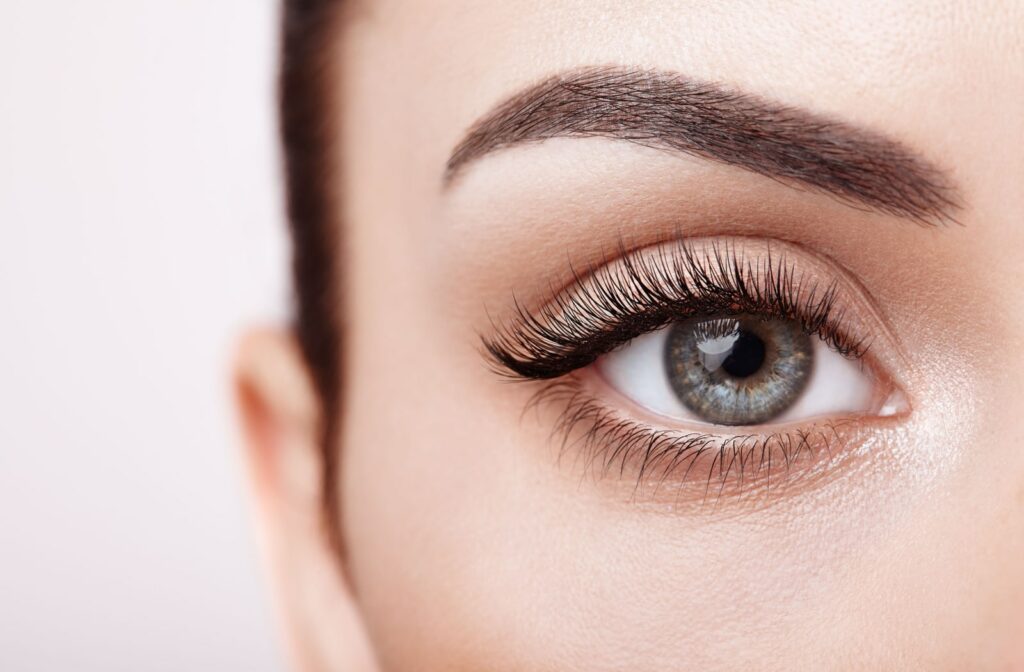Most of us probably take our tears for granted, but the complex mechanism that keeps our eyes well-lubricated and hydrated is a marvel. The tear film is surprisingly sophisticated and incredibly complex, and it’s a key component in maintaining healthy vision. Yet, many people are unaware of its existence and importance.
The tear film is a mixture of oil, water, and mucus that covers the entire surface of the eyes to protect the eye from environmental irritants and infections while keeping the eyes comfortable. It keeps the ocular surface smooth to provide a clear refractive surface so light reaches your retina for visual clarity.
Imbalances in the tear film can cause dry eye syndrome, which is becoming increasingly common among patients. If you’re experiencing dry eye or eye discomfort, visit your optometrist for treatment options and solutions.
What Is Tear Film?
The tear film is a thin, transparent layer of liquid that coats the surface of the eye, including the cornea, the conjunctiva, and the sclera. Its primary function is to keep the eye moist and lubricated, preventing dryness and damage to delicate tissues. By providing a barrier between the environment and eye structures, the tear film helps keep out particles, infections, and irritants that can cause eye discomfort.
Why Is Tear Film Important?
The tear film plays several crucial roles in eye health.
- It helps to provide clear and sharp vision by contributing to the refraction of light as it enters the eye.
- It flushes away debris and bacteria, preventing infection and inflammation.
- It contains antibodies and other immune-boosting substances that help to protect the eyes from infection.
3 Layers of the Tear Film
The tear film comprises 3 distinct layers, each with a specific function: the lipid, aqueous, and mucin layers.
- The lipid layer is the outermost layer and consists of a thin film of oil that helps to prevent evaporation of the aqueous layer and keeps the tear film stable and smooth.
- The aqueous layer is the middle layer and is composed primarily of water and electrolytes. This layer provides moisture and nutrients to the cornea, which is essential for its health and survival.
- The mucin layer is the innermost layer and is a sticky and viscous substance that helps to anchor the tear film to the eye’s surface and improve its wetting properties, reducing friction as you blink.
Your Tear Film & Dry Eye
Imbalance in the tear film can contribute to dry eye syndrome and cause irritating symptoms, including:
- Burning or stinging
- Grittiness
- Stringy mucus or watery eyes
- Eye redness
- Sensitivity to light
- Blurry vision
- Difficulty wearing contact lenses
Dry eye can occur when the tear production is insufficient or the tears are of low quality, leading to aqueous deficient dry eye or evaporative dry eye, respectively.
Aqueous Deficient Dry Eye
Aqueous tear-deficient dry eye occurs when there is not enough water in the middle aqueous layer of your tear film. The lacrimal gland in the eyelid produces the aqueous layer of tears, but inflammation and diminished tear production can occur. This can be caused by several conditions, including:
- Sjögren’s disease
- Other autoimmune conditions, such as rheumatoid arthritis or multiple sclerosis
- Hormone replacement therapy
- Blepharitis
- Seborrheic dermatitis
- Certain medications, including antihistamines or antidepressants
Aqueous tear-deficient dry eye requires addressing the underlying health condition. However, various treatment options are still available, such as artificial tears or prescription eye drops.
Evaporative Dry Eye
The most common type of dry eye is evaporative dry eye, which occurs when the lipid layer of your tear film is damaged or insufficient. This can be caused by various factors, including meibomian gland dysfunction (MGD), a condition where the meibomian glands in your eyelids don’t produce enough oil.
Without enough oil, the watery layer of your tear film evaporates too quickly, leading to dryness. Other causes of evaporative dry eye include:
- Environmental factors such as smoke, wind, or air conditioning
- Extended screen use
- Overwearing contact lenses
To treat evaporative dry eye, you may need to improve the amount and quality of lipids in your tear film through eye drops, eyelid hygiene, dietary supplements, or in-office treatments, including low-level light treatment, intense pulsed light therapy, or thermal pulsation therapy.
Develop a Healthy Tear Film
The tear film may not be the most glamorous part of the eye, but it is undoubtedly one of the most critical. Without a healthy and functional tear film, our eyes would be vulnerable to a range of infections, discomforts, and vision problems.
If you’re experiencing dry eye, it may be caused by your tear film. Book an eye exam at Higgins Brothers Vision Care to assess your eye and explore treatments to help restore comfortable, clear vision to your eyes.




